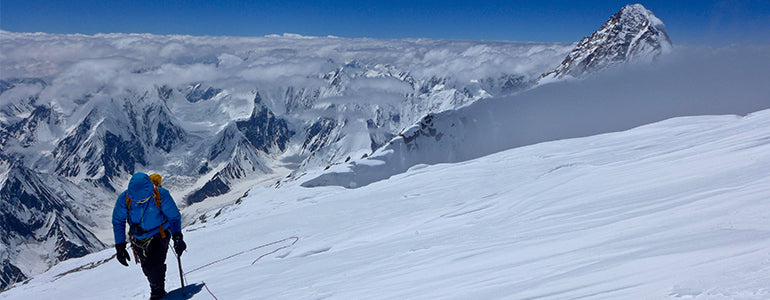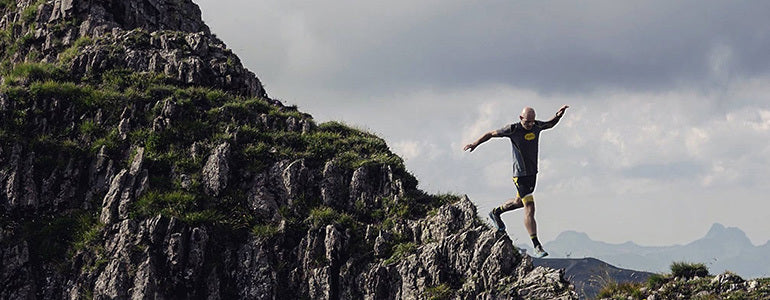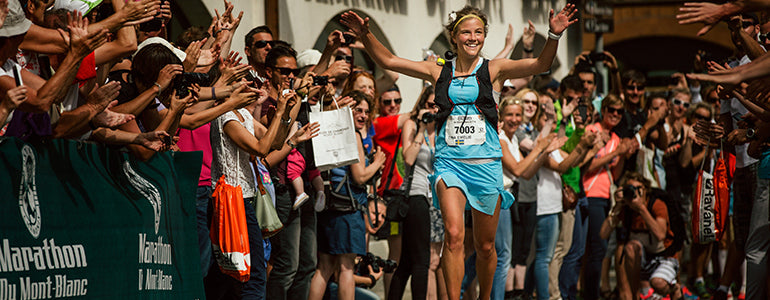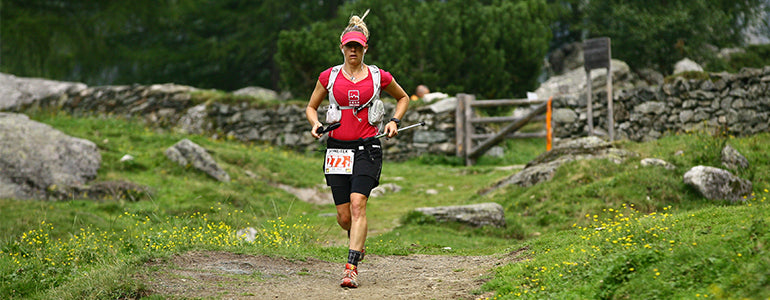

Suunto Blog

Luka Lindi? takes on Gasherbrum IV
Mountaineer Luka Lindič has been climbing one of the toughest peaks on the planet – Gasherbrum IV in Pakistan.
Climbing Gasherbrum IV © Luka Lindic
He and Aleš Česen made it to the North Summit, around 20metres below the 7932-meter-high main summit, after battling fierce weather that made reaching the summit impossible. Of course the guys are pleased with how far they reached on this treacherous route, in difficult conditions.
They originally planned to take a new route, via the North West face but that was completely impossible in bad weather. Before tackling the G4 they scaled Broad Peak, making them the only team to successfully summit that mountain this season.
This climb was used to acclimatise, and got the guys in the right frame of mind mentally for the big route, Luka says: “Some people might think using a climb like Broad Peak to acclimatise might take away a lot of fitness, but I think if you plan to climb a route like we did on G4 then it shouldn’t be a problem. If it makes you tired, then you are not prepared enough! It took away a bit for sure, but we benefited lots more than we lost. A climb like that is also important from a mental point of view, as a final check.”
Luka Lindič and Aleš Česen © Luka Lindic
The weather in the area meant the Alpine style of climbing the pair used gave them an advantage over other teams climbing differently. Luka says: “The other teams were climbing in a classically Himalayan style and spent lots of time and energy preparing. Now, it seems this is how it will be in Pakistan. The weather is not stable and you get a window of maybe two days. If you climb Alpine style like we did you are flexible and it’s easier to get up and go when there is a good weather window. With Himalayan climbing that’s a lot more difficult to try. That was our advantage this time.”
Feeling strong after Broad Peak they started on G4, dubious they’d make it far in bad conditions. However, they managed to climb through the weather and pushed on until they made the North Summit.
The guys tried to wait for bad weather to pass © Ales Cesen
Luka says: “It was pretty bitter sweet. On one side you know you will not climb G4 but you know inside you did the maximum you could. It was a cool experience after struggling all day to reach the North summit we had sun for a few minutes, we could even see the summit for a few minutes. We had pushed hard already and decided the summit wasn’t possible, but were happy with what we did.”
The guys had to rappel back down to avoid being swept away by avalanches. Now back from the trip he can contemplate the attempt, and he knows he’ll go back. He’s got some technical climbing planned in the meantime, he says: “I will go climbing in China for one month in September then my plan Is to spend some longer time in the Alps. I’ve been on expeditions this year so I feel like I have missed some technical training in the Alps and I want to get back to the level of climbing I want to be at, as doing expeditions you lose a bit of that.”
Main image ©Luka Lindic

How to get through a 100-mile ultra marathon
Gediminas Grinius won silver at this year’s 170 km (105 mile) Ultra Trail du Mont Blanc – UTMB, one of the world’s premier ultra marathons. His secret? It’s staying relaxed and finding his inner warrior. Gediminas finding his inner samurai before an ultra marathon in Japan. © Gediminas Grinius
Lithuanian ultrarunner Gediminas Grinius is riding a high after an outstanding performance at UTMB in France. Winning silver tastes especially sweet because in last year’s race he pulled out due to injury.
“Before this year’s race I felt very good, the best shape ever,” he says. “My preparation was excellent.”
Here are Gediminas’s tips for the different phases of an ultra marathon.
Race day morning
It’s easy to feel pressure and stress before a race begins. It’s important to do what you need to do to stay calm. The best way to do that is to stick to your routine, rather than adjusting it for others. I like to spend time with my family, just enjoying life, before a race begins.
© Gediminas Grinius
The start
The beginning of a race is often very fast and chaotic. Later in the race, many runners that started too fast are dead. It’s important to be patient, to keep calm and follow your own pace. Don’t try to keep up with other runners. The race is long so it’s good to keep reserves for later. Now it’s time to relax and enjoy the race.
It’s also important to begin and maintain your nutrition routine, whether you measure it by aid stations or by time.“Pain is temporary, glory lasts forever.”
Settling in
As the race settles down, my plan is to stick to other runners, following their pace because together we’re stronger. It helps me to feel stronger and I can push more from that place.
I’m not a good runner in the beginning. The first 30 or 40 km I’m warming up. After that I know how the race will be because I can feel how my body is reacting. If my body lets me go at a good pace, then I go with that. If it’s not my day, then I go with that, and back off.© Gediminas Grinius
The suffering
Eventually you reach a point when you are suffering. It’s impossible to avoid. You know it’s going to happen. You must be patient. I always remind myself, “pain is temporary and glory is forever”. If you’re suffering, remember it will pass.
When I’m struggling, I use a mental technique. For example, when I was in Japan competing in the Ultra-Trail Mt Fuji, I imagined I was a samurai warrior fighting bad guys. It’s a kind of mental game to cope with difficulties. I visualise myself as different characters.© Gediminas Grinius
“As a father, I remember I’m setting a good example to my children – to finish whatever you start.”
Ending strong
During the final stage, I’m thinking about things that generate positive emotions. For example, I think about my family and how grateful I am they supported me during the long night of the race. It gives me some push and I can move faster. It’s about cultivating good vibes. I know I will feel so much when I see them. As a father, I remember I’m setting a good example to my children – to finish whatever you start. My kids see how stubborn I am and that I do what I love. It’s a good lesson for them.
Follow Gediminas's adventures on his Facebook page.
Other stories with Gediminas Grinius:
Tips for transitioning from road to trailThe Gediminas way of recovery
Main image: © Gediminas Grinius

Recovering from injury with Emelie Forsberg
When you’re doing a sport you love, getting an injury can be devastating. Something mountain athlete Emelie Forsberg knows too well. After ACL surgery in February she has just won KIMA (August 29, 2016). Going from being unable to walk to winning the tough 52km skyrace, she’s undoubtedly delighted. A balanced state of mind helped her get there, and that meant embracing the dark days, while celebrating every tiny rehab victory. We’ve spoken to her about the process, here’s what she had to say.
Emelie Forsberg has recovered after ACL surgery. ©Jordi Saragossa
First things first, how are you feeling after winning KIMA?
I feel good, my legs feel fine today! I ran very conservatively as it’s still early to do a lot of running, but I wanted to try. I ran carefully and I knew it was my kind of course, there are some parts where you have to go fast but it has a lot of very technical parts and I like that. I knew I could do OK but I really did not know how I would be after four hours as I hadn’t been able to run and I was nervous. But I had enough energy at the end and I’m very happy!
Looking back on your surgery, what was important in those early days?
I was very lucky to have surgery immediately. The first days after the injury were horrible. I think maybe it was better it wasn’t me who caused the injury, there was a crash, as I would have been very angry at myself. I was sad as I have devoted my life to being a mountain athlete so it was like my whole world disappeared. It was important to let myself feel like that, and it shows it really means something to me. It was hard, but I knew it would end and I began studying to understand the process and the anatomy behind everything.
What did you do physically to get to where you are now?
I was really careful with rehab and I didn’t do too much in the beginning. I had some simple exercises to do every day. I learned to walk again properly after the first four weeks as I couldn’t walk, it was crazy. I took it step by step and had goals, I never pushed further than I knew was possible and that was important. On week 9 I wanted to run a few steps, and I felt good that day, so I did it. It’s important to have small goals and adjust them as you progress.
Taking small steps got her back on the mountains
How did you stay strong mentally?
It was important to talk to friends, particularly those who also had injuries. You can share something that’s very hard, as they’ve also had something they love taken away. I had very dark days too, but I didn’t dislike them! I liked to have dark days as I was sad and I wanted to be sad as so much had been taken away but I also knew I could step out of that, I could have some distance from it. It’s important to remember there’s more to life than sport. I tried to focus on other things as it sucks to have something you love taken away!
Yoga helped you a lot during your recovery, is that right?
I did a little yoga from week 2 and I think when I was feeling feeling a bit low it would have been good to do more, but when you’re not in a good mood, it’s hard even to do yoga! Maybe yoga was most important to help me know my body, as you really feel everything.
Emelie will get back to skimo this winter
So, what’s next for you?
I’m travelling to India to do the final 200 hours of yoga teacher training. I think it’ll be pretty intense. After that I think I’ll do some more running, then I’ll start to prepare for skiing.
Are you nervous about getting back to ski mountaineering?
I feel quite ok actually. I have two seasons, so now that I am back running it feels natural to get back into skis. I feel comfortable going downhill again so I’m feeling good about it!
Follow Emelie on her website, Facebook and instagram.
Main image ©Jordi Saragossa

Jukka Saarikorpi takes over @suuntodive Instagram
Passionate diver, photographer and Suunto’s own diving business line manager, Jukka Saarikorpi is hosting the @suuntodive Instagram account for a week, starting today. Make sure to follow to catch his inspiring images! USS Vanderberg, Florida Key West. © Jukka SaarikorpiWhere are you from, Jukka? I come from Finland. I was born in Tampere and now and live here in Helsinki. I work for Suunto as a diving business line manager. Where do you dive regularly? We tend to travel quite a bit for my vacations so most of my dives are in warm water. We also test diving products for Suunto in the Ojamo abandoned limestone mine, about 100 km from Helsinki in Lohja. There, and also in Baltic Sea, I occasionally do cold water diving. I enjoy warm water diving more and photographing marine animals. In Finland, you see a lot of wrecks, but wildlife is very rare to see while diving. © Jukka SaarikorpiWhat inspires you about the underwater world? I have always enjoyed being near the sea. I used to do a lot of competitive sailing, which I still do. Diving became something that I can enjoy in nice locations. It gives me something exciting to do in my free time. Nowadays, it has turned into work as well, but I still love it! How would you describe your photography style? I mostly use a wide-angle lens and like shooting big animals, wrecks and divers. I try to capture the moment underwater when the light conditions are changing. It makes diving more interesting when you have more challenges to get the “perfect” picture. Is there a story you wish to tell with your images? I love to inspire people to start diving and to appreciate the ocean more. The ocean is something I really value and I hope I can encourage other people to appreciate it too. Where to follow your adventures? You can see my underwater photography on my Facebook page, on Instagram and on my photography website.
Main image: Moalboal, Philippines. © Jukka Saarikorpi

The one thing every freediver needs
A dive computer makes freediving safer, more enjoyable and helps to improve performance.
Ute Gessman began freediving before the first dive computers were on the market. The AIDA sport officer and competition freediving judge would instead in those days carry a manometer (a mechanical device for measuring pressure) down with her, which was often inaccurate.
Since then, dive computers have become a must for every freediver, she says.
“For freediving, you need a freediving computer,” she says. “Without one, you have no idea where you are.”
Ute Gessman is competition freediving judge and works for AIDA. © Ute Gessman
Here’s why a dive computer is essential kit.
Safety first
A dive computer can tell you how long you’ve been under the water, your depth, and when you must return to the surface. It also helps your buddy at the surface to keep track of how your dive is going. “I can see when he or she left the surface, how long they’ve been under and when he or she should reach the bottom,” says Suunto’s dive business line manager, and freediver Jyri Vehmaskoski. “A dive computer also tells me when I should go down to do the safety dive, about 10 or 15 m, to make sure they’re okay as they come up.”
Jyri Saarikorpi is a freediver and spearfisherman. © DeeDee Flores
Preparation
“A freediving computer helps you prepare on the surface for a dive,” Ute says. You can use the dive computer to time different breathing exercises, to keep track of your warm up dives, and to tell you when you should commence the dive.”
Suunto D4i Novo is a lightweight dive computer that has four diving modes, including freediving.
Overcoming anxiety
“When most people start freediving, they are a little bit afraid to use the free fall to go down the whole way,” says Ute. “Using a dive computer helps them to relax because it tells you how long you should descend before turning back. “Some people want to work by a time, so they put a dive time in, so they know when two minutes, for example, has passed then they need to go back.”
© Ute Gessman
To manage dive stages
Jyri uses his dive computer to manage the difference stages of a dive. “There are four stages when I dive deep: the first stage is obviously on the surface. I make three stronger kicks to get the dive going with momentum and then I start to relax after that. The second stage involves kicking very slowly, focusing on relaxation. Third stage: I do mouth-fill at about 24 to 27 m (an equalization technique). I set an alarm in my dive computer to mark that. The fourth stage: I stop kicking between 30 and 40 m because my lungs are squeezed and I have negative buoyancy so I don’t need to kick. I use a sound on my computer to signal this. Then I just shut my eyes, relax and do the free fall. During free fall my dive computer notifies with sound at certain depths so I know where I am at.”
After the dive
A dive computer records each and every dive in a session so once you’re back on land you can inspect the profile of each one. “The profile shows you if you had a good or bad start, if you took too long to go down, when you might have had equalization problems, whether you dived straight, down, or if you had problems,” Ute says. “You can make the profile really big so you can see every second. You can see exactly how you went down and back again. It gives a lot of information for improving performance.”
Click to find out more about the Suunto D4i dive computer!

How to smash a stage trail race
Trail runner Rene Unser tells us what it takes to keep going during a multi-day race.
Image: Klaus Fengler (Feature image: Schneider Outdoor Visions)
Five-time Trans Alpine Run competitor and coach Rene Unser is passionate about trail running, in particular partnered staged races. No wonder, as she fell in love with the sport after her would-be husband coaxed her from the roads and onto the trails. She never looked back and she shares some of that passion here, as she explains what’s needed to smash a staged run.
Strategy is key
Having a fine tuned strategy is something important to Rene, in fact it’s one of the things she loves most about these races. She says: “I enjoy the strategy involved in preparation, racing and recovery. The preparation forms my lifestyle and it’s the favourite part for me.”
Care for your partner
Being in sync with your partner could make or break a race. Rene says: “Learn to work with your partner on and off the trails. Very rarely will you and your partner feel good at the same time. You need to work together and understand what the other needs.” Image: Klaus Fengler
Perfect your pace
Can you keep that pace through the whole race? Rene says you need to find out: “Learn your pace and check in with yourself – can you sustain this pace for the whole race, for many days. Try splitting your race into half and run the first half at a moderate, comfortable pace. After the half way mark you can reassess your capability to increase your efforts as you get closer to the finish.”
Know your strengths
No one has a perfect race, and that’s ok. “Most people will learn their strengths and weaknesses as their training progresses. Know there will be stages that won’t always match your strengths,” says Rene. “Do research on the daily profiles and recognise when the terrain will complement your strengths and try to capitalise on this,” she adds.
Get started
Perhaps not an eight-day trail run, but get out on the trails. Rene says: “I really encourage people if they love running long distances to give it a try. Stage races bring the world together, and I’ve met so many people and travelled to so many amazing places, it’s more than just a race!” And road runners should start slowly, she adds: “It’s a good idea to learn technique from a coach to avoid injury or join a running club to learn from others. Often the first thing I tell road runners when they make the transition to trails, is to change their mind-set, as we do a lot more hiking and road runners are not typically used to this.”
Follow Rene on her website, Facebook, instagram and personal website.
READ MORE:
5 INVALUABLE STAGED TRAIL RACE TRAINING TIPS
HOW YOGA CAN MAKE YOU A BETTER MOUNTAIN RUNNER
FOUR MYTHS ABOUT ULTRA-RUNNING THAT YOU NEED TO KNOW










































































